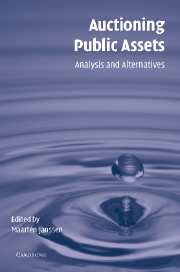Book contents
- Frontmatter
- Contents
- List of figures
- List of tables
- List of contributors
- Preface
- Introduction
- Part I Theory
- 1 Auction theory for auction design
- 2 Beauty Contest design
- 3 Preventing collusion among firms in auctions
- 4 Levelling the playing field in auctions and the prohibition of state aid
- 5 Allocation mechanisms and post-allocation interaction
- Part II Case studies
- Index
- References
3 - Preventing collusion among firms in auctions
Published online by Cambridge University Press: 03 December 2009
- Frontmatter
- Contents
- List of figures
- List of tables
- List of contributors
- Preface
- Introduction
- Part I Theory
- 1 Auction theory for auction design
- 2 Beauty Contest design
- 3 Preventing collusion among firms in auctions
- 4 Levelling the playing field in auctions and the prohibition of state aid
- 5 Allocation mechanisms and post-allocation interaction
- Part II Case studies
- Index
- References
Summary
Introduction
Collusion among bidders in auctions is a serious concern for those interested in designing procedures to allocate public assets whether the goal of the process is efficiency or revenue maximisation. In either case, bidders acting collusively can seriously impair an auctioneer's ability to accomplish their goal. There has been a wide variety of examples of collusion discussed in the economic literature, including collusive bidding for school milk contracts (Pesendorfer, 2000), in cattle auctions (Phillips, Menkhaus and Coatney, 2001), in timber auctions (Baldwin, Marshall and Richard, 1997) and, of course, in spectrum auctions, which will be the focus of this study. We will present a brief survey of recent literature on collusion problems mostly in ascending auctions and then go on to discuss the Federal Communications Commission's (FCC) experience in dealing with collusion in their auctions as a case study in how the lessons from this literature can be applied.
We will be discussing both ascending and sealed-bid auction formats and the incentives for collusion embedded in each, but the focus will be on ascending auctions. Ascending auctions are the primary focus of the literature on collusion in auctions owing to the fact that ascending auctions are more susceptible to ‘in-auction’ collusion than sealed-bid auctions. The term in-auction collusion is used to refer to collusion that can emerge and be enforced inside a single auction.
- Type
- Chapter
- Information
- Auctioning Public AssetsAnalysis and Alternatives, pp. 80 - 107Publisher: Cambridge University PressPrint publication year: 2004
References
- 2
- Cited by



